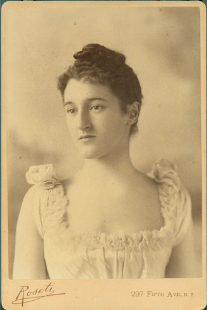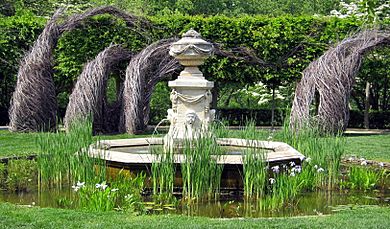Beatrix Farrand facts for kids
Quick facts for kids
Beatrix Farrand
|
|
|---|---|
 |
|
| Born |
Beatrix Cadwalader Jones
June 19, 1872 New York City, New York, U.S.
|
| Died | February 28, 1959 (aged 86) |
| Nationality | American |
| Alma mater | Arnold Arboretum, Columbia School of Mines |
| Occupation | Architect |
| Spouse(s) |
Max Farrand
(m. 1913; |
| Parent(s) | Mary Cadwalader Rawle Frederic Rhinelander Jones |
| Projects | Dumbarton Oaks, Abby Aldrich Rockefeller Garden |
Beatrix Cadwalader Farrand (born Jones; June 19, 1872 – February 28, 1959) was an important American landscape architect. This means she designed outdoor spaces like gardens, parks, and college campuses. She created about 110 gardens for homes, public parks, and even the White House.
Some of her most famous works that you can still see today include Dumbarton Oaks in Washington, D.C., the Abby Aldrich Rockefeller Garden in Maine, and parts of the campuses at Princeton, Yale, and Occidental.
Beatrix Farrand was one of the first eleven members of the American Society of Landscape Architects. She was also the only woman among the founders. She is known as one of the most talented people in the early days of landscape architecture.
Contents
Early Life and Learning
Beatrix Cadwalader Jones was born in New York City on June 19, 1872. Her family had been gardeners for many generations. She spent her summers at the family's home, Reef Point Estate, on Mount Desert Island, Maine.
When she was twenty, she met Charles Sprague Sargent, a botanist and professor at Harvard University. He became one of her main teachers. Sargent even named a plant, Crataegus jonesae, after her because she found it.
In 1893, Farrand lived at Sargent's home and studied landscape gardening. At that time, there wasn't a special school for it. She learned about botany (the study of plants) and how to plan land. She also studied at the Columbia School of Mines to learn skills like drafting and surveying.
She was inspired to use native plants in her designs. She also learned from famous British garden writers like William Robinson and Gertrude Jekyll. Jekyll's books taught her the importance of natural plantings.
On December 17, 1913, Beatrix married Max Farrand. He was a historian at Stanford University and Yale University.
Designing Landscapes

Beatrix Farrand started her landscape design business in 1895. She worked from her mother's house in New York. At first, she designed gardens for homes, especially for people living near her summer home in Maine.
Because women were not allowed to work on public projects, she focused on private gardens. Her mother and aunt, Edith Wharton, helped her meet important people. This led to many big projects. Within three years, she was so well-known that she became the only woman among the founders of the American Society of Landscape Architects.
In 1899, Farrand helped plan the initial site and plantings for the Washington National Cathedral in Washington, D.C. In 1912, she designed a beautiful walled garden called Bellefield in Hyde Park, New York. This garden is still there today.
For the White House, Beatrix Farrand was asked to design the East Colonial Garden and the West Garden in 1913. These gardens were later redesigned. She also worked for J. P. Morgan, designing the grounds of his home in New York City. She continued to advise him for thirty years.
Her most famous work is at the Dumbarton Oaks estate in Washington, D.C. She worked on this project from 1922 to 1940. Her design was inspired by gardens she saw in Europe, especially Italian Renaissance gardens. She created a beautiful connection between the buildings and nature. The gardens have formal terraced areas that step down a hill, then become more natural near a creek.
In 1928, Beatrix and her husband moved to California. Her husband became the first director of The Huntington Library. Farrand found it hard to get new clients in California. Other landscape designers were already very popular there. She mostly got projects through friends, like the Casa Dorinda estate in California. She also worked on projects at Occidental College and the California Institute of Technology (Caltech).
Farrand often traveled by train across the country for her projects in the eastern U.S. One of these was a Chinese-inspired garden for Abby Aldrich Rockefeller in Maine. She also helped John D. Rockefeller Jr. design planting plans for the carriage roads at Acadia National Park in Maine. These roads are still used today.
Some of Farrand's private gardens that still exist in the eastern U.S. are:
- Dumbarton Oaks in Washington, D.C.
- The Harkness summer home 'Eolia' in Waterford, Connecticut, now a park.
- The Rockefellers' estate 'The Eyrie' in Maine.
She also worked with Edith Wharton on the gardens at Wharton's home, The Mount. In 1942, she designed the gardens at Green Spring Gardens Park in Virginia.
In California, the Santa Barbara Botanic Garden shows her skill with native plants. In England, she worked on 'Dartington Hall' for Dorothy Payne Elmhirst.
Her drawings, library, and plant collections are kept at the University of California, Berkeley. Some documents for Dumbarton Oaks are at its library.
In 2014, Farrand was honored for her work on the Peggy Rockefeller Rose Garden at the New York Botanical Garden. This garden was recognized as a winning site in the Built by Women New York City competition.
Designing College Campuses
Farrand designed college campuses with three main ideas:
- Using plants that would bloom all year.
- Highlighting the buildings while hiding any flaws.
- Using tall and climbing plants to make small spaces between buildings feel larger.
Her campus designs were practical, simple, and easy to take care of. She was the first consulting landscape architect for Princeton University from 1912 to 1943.
Today, when new buildings are planned at Princeton, architects often look at Farrand's papers. She was also the consulting landscape architect at Yale University for twenty-three years. Her projects there included the Marsh Botanical Garden. She also improved campuses at the University of Chicago, Occidental College, and the California Institute of Technology. Beatrix Farrand also designed for the Pennsylvania School of Horticulture for Women. Later, she advised the Arnold Arboretum at Harvard University.
Later Years and Legacy
In her later life, Farrand wanted to create a landscape study center at her home, Reef Point Estate, in Maine. She continued to develop the garden and prepare the property for this public center. She even published a newsletter about the garden's progress.
However, after a wildfire and not enough money, she decided in 1955 to close the center. She sold the property and used the money for her last years. John D. Rockefeller Jr. bought many of Reef Point's large plants for his Asticou Azalea Garden in Maine. These plants still bloom there today. About 2000 of her plant samples were given to the University of California, Berkeley.
Farrand spent her last three years at Garland Farm, the home of her friends, in Maine. Here, she created her final garden, a small and personal space. Beatrix Farrand died at age 86 on February 28, 1959.
The Beatrix Farrand Society bought Garland Farm in 2004. Their goal is to promote horticulture and landscape design, focusing on Farrand's life and work. They plan to continue her original educational mission and preserve Garland Farm and her last garden.
Images for kids
See also
In Spanish: Beatrix Jones Farrand para niños



